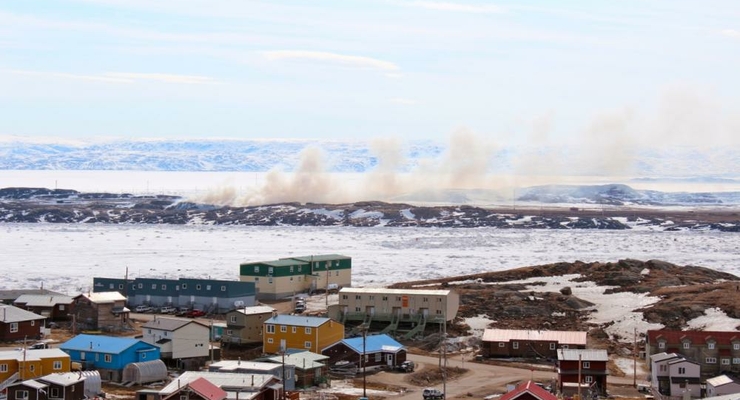Bulletin: Questions and Answers Iqaluit dump fire

Bulletin: Questions and Answers Iqaluit dump fire
June 13, 2014
The Government of Nunavut is working closely with the City of Iqaluit, Environment Canada and Health Canada to monitor the dump fire, air quality and develop a course of action.
Current Status
Q: What is the status of the Iqaluit dump fire?
A: The Iqaluit Fire Department considers the fire under control and in a smoldering stage. The fire is not posing a threat to surrounding buildings and infrastructure.
Smoke patterns have changed and the smoke is lighter and more transparent than before.
Q: What was the motion the City of Iqaluit recently passed?
A: Motion from the City of Iqaluit’s council meeting of June 11, 2014: "That the fire chief, at his discretion, extinguish the fire as he sees fit, with the assistance with experts in the field of dump fires and seek help from the Government of Nunavut to be done as soon as possible."
The City of Iqaluit has asked the Government of Nunavut to assist with developing plans to extinguish the fire and assess various options.
Environment
Q: Is the air quality in Iqaluit being monitored?
A: Yes. Through the National Air Pollution Surveillance Network (NAPS), the Government of Nunavut in partnership with Environment Canada regularly monitors urban pollutants. This equipment measures ozone and nitrogen oxides, and particulate matter in the 2.5 micron range, but not the chemical compounds released by the dump fire.
On June 8 and 9, Environment Canada sent two technical staff from its National Environmental Emergency Centre to conduct preliminary air monitoring that targeted the smoke plumes of the fire. Measurements were taken with handheld emergency devices in 15 locations for particulate matter.
The results show that the concentrations of these substances drop off significantly just outside the perimeter of the dump. However, there were some particulate matter spikes detected up to a kilometer away based on things like the wind, rain and topography.
Additional air quality monitoring equipment from Health Canada and Environment Canada is expected to be set up this weekend. This will help measure known by-products of dump fires, like volatile organic compounds (VOCs), polyaromatic hydrocarbons (PAHs), dioxins and furans.
Q: What is in the dump fire smoke?
A: The smoke contains a mixture of chemicals and fine particles, depending on what is burning and the burn temperature at the time. Typically, the dump holds materials such as plastic, wood, metal, paper, cardboard, food and electronics. There is a separate location for old tires, scrap metal and vehicles, and paint cans. There should be very little, if any, paint or tires in the fire. Advanced air quality monitoring equipment will take samples and provide a better idea of what is in the dump fire smoke.
Q: How often will smoke blow into the city?
A: There will be times when smoke from the Iqaluit dump fire blows into the city. This tends to happen when the winds are from west. The majority of the winds are from the north/northwest or south/southeast, which means smoke does not blow into the city. We will continue to provide public service announcements about any wind shifts.
Health
Q: What should I do if smoke blows into the city?
A: You should minimize your exposure to smoke by staying indoors as much as possible. Keep your doors and windows closed, and set air exchangers to recirculate indoor air or turn them off. If the smoke is still getting into your home, you should consider going to a family member or friend’s house in another part of the city where there is less smoke. If you have to go outside, limit physical activity.
Q: What are the health effects from the smoke?
A: Smoke can be irritating to the eyes, nose and throat and may cause nausea. Some people may be more at risk than others to health effects from the smoke. This includes people with chronic lung and heart disease. Young children may also be more at risk because their respiratory systems are still developing and they breathe in more air for their weight than adults. Pregnant women should also protect themselves from exposure to smoke.
Q. What are long-term health effects from exposure to smoke from the dump fire?
A: The long-term risks from short-term exposure to smoke from the dump fire are expected to be quite low. The air quality monitoring equipment being put in place will provide us with more information and help verify the initial sampling done by Environment Canada.
Q: What symptoms should I look for?
A: You should watch for wheezing, shortness of breath, tightness in your chest, light headedness and dizziness. The smoke may also be irritating to your eyes, nose and throat and may cause nausea.
Q: What should I do if I develop symptoms related to the smoke, like trouble breathing or tightness in my chest?
A: If you don’t feel well and can’t manage your symptoms on your own, you should seek medical attention.
Q. Will wearing a mask help to reduce exposure to smoke?
A: We are not recommending masks for the public. Surgical masks are not helpful because they don’t filter out the particulates. We recommend minimizing your exposure, rather than wearing a mask that may not be effective.
Q: Is there anything else people can do to protect themselves?
A: You should decrease your exposure to smoke from the dump fire. Try to stay indoors as much as possible. Keep your windows and doors shut, and set air exchangers to recirculate indoor air or turn them off. Don’t smoke indoors, as this will cause the air quality to deteriorate quickly. Limit your outdoor activities.
###
Media Contact:
Cate Macleod
Director of Communications
Department of Executive and Intergovernmental Affairs
867-975-6049